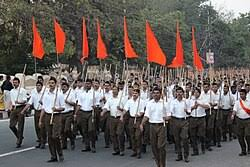Between 1918 and 1921, the Khilafat movement was supported by Mahatma Gandhi and the Congress, leading to mass mobilization of Muslims. As a counter-reaction, Hindu political leaders formed the Akhil Bharatiya Hindu Mahasabha. Hedgewar and Moonje became its members.
The year 1921 saw the horrific Moplah riots in Kerala, against Hindus. It was the first of more than 20 rounds of communal flare-ups across India. Frustrated by the response of the Hindu Mahasabha, Hedgewar resigned and, on 27th September 1925, he and Moonje co-founded the RSS.
The Moplah revolt or Malabar riots often gets branded as a freedom struggle gone wrong. Far from it, it was a genocide.
In the Indian education system, particularly in Kerala, history teaches the 'Wagon Tragedy' next to the 'Jallianwala Bagh Massacre'. Naturally, one tends to conceive the Wagon Tragedy and its victims as part of the Indian Independence movement.
There is no question that the act committed by the British against the Muslim detainees is merciless – squeezing over 90 people into a freight wagon, ultimately suffocating and killing 67 of them. Everyone knows this much of the history but not much about the events that led to this incident.
It has been argued that those who were bundled into the wagon weren't freedom fighters; they were rioters who brutally murdered thousands of Hindus and displaced tens of thousands in the Malabar region of Kerala. (Swarajya magazine)
On 27th September 1925, an organisation was launched that would influence the politics of modern India. It was the Rashtriya Swayamsevak Sangh (RSS) and its first Sarsanghchalak was Keshav Baliram Hedgewar.
Hedgewar was a protege of Congress leader Balkrishna Moonje, who was an associate of Bal Gangadhar Tilak. On Moonje’s advice, Hedgewar completed his medical studies in Calcutta and, during this time, he became involved in revolutionary societies like the Anushilan Samiti.
On his return to Nagpur, Hedgewar became involved in local politics under his mentor Moonje. In December 1920, he was a volunteer making arrangements for the Indian National Congress session. He set up a small group for this purpose and called it Rashtriya Swayamsevak Dal.
It was Hedgewar who introduced the concept of daily ‘shakhas’ as the first permanent units of the RSS, in Nagpur city. Next, the concept of ‘pracharaks’ or ‘officers’ who renounce their family and careers and work full time for the cause of the RSS, was set up.
When Hedgewar’s health declined, he handed the reins of the RSS to Madhavrao Golwalkar, in 1940. It was Golwalkar who made the RSS a pan-India force with shakhas across India. He was one of the strongest proponents of Hindutva and a Hindu Rashtra.
After India’s independence in 1947, the RSS, which had traditionally eschewed politics and was a purely social organization, began to support the Jana Sangh founded by Dr Syama Prasad Mookerjee. The Jana Sangh would evolve into the Bharatiya Janata Party.
With the setting up of organizations such as the Vishwa Hindu Parishad, Swadeshi Jagran Manch, Bajrang Dal, Rashtriya Kisan Sangh and Rashtriya Mazdoor Sangh, the RSS has evolved into the fountainhead of what we know as the ‘Sangh Parivaar’ today.
(from Economic and Political Weekly)
Upto 1937 the Hindu Mahasabha was a loosely organised group collected around prominent individuals. The two major issues dividing the reformers (in the Hindu Mahasabha), led by Lajpat Rai and Sharaddhanand, from the Sanatanists (the orthodox ones), led by Parmanand, Munje and Kelkar, were the elimination of caste restrictions and political participation.
In 1937 Savarkar was elected President of the Mahasabha and settled these differences by resolving to build it into a political organisation representing the Hindus.
By turning the Hindu Mahasabha into a political organisation, Savarkar ensured that whatever support the RSS had rendered to the Mahasabha would cease.
Many RSS members were active in the Congress.
During World War II, the Mahasabha sought to enroll Hindus in the army and to negotiate with the British to get itself represented on various government councils.
This policy was to fail The British at the Simla Conference in June, 1945 treated the Congress as the representative of caste Hindus and the Muslim League as the representative of the Muslims.
The weakness of the Hindu Mahasabha was the more apparent because — unlike the RSS — it lacked any youth, peasant or para-military foundations. It tried to make up for this lack by appealing to the RSS, but in vain. It could not become a mass organisation because so many of its supporters were big landlords who were unwilling to allow any hint of mass mobilisation.
Meanwhile, the RSS — due to its unstinted help to Hindu refugees during and after partition — had increased its influence throughout northern India.









thanks!
ReplyDelete